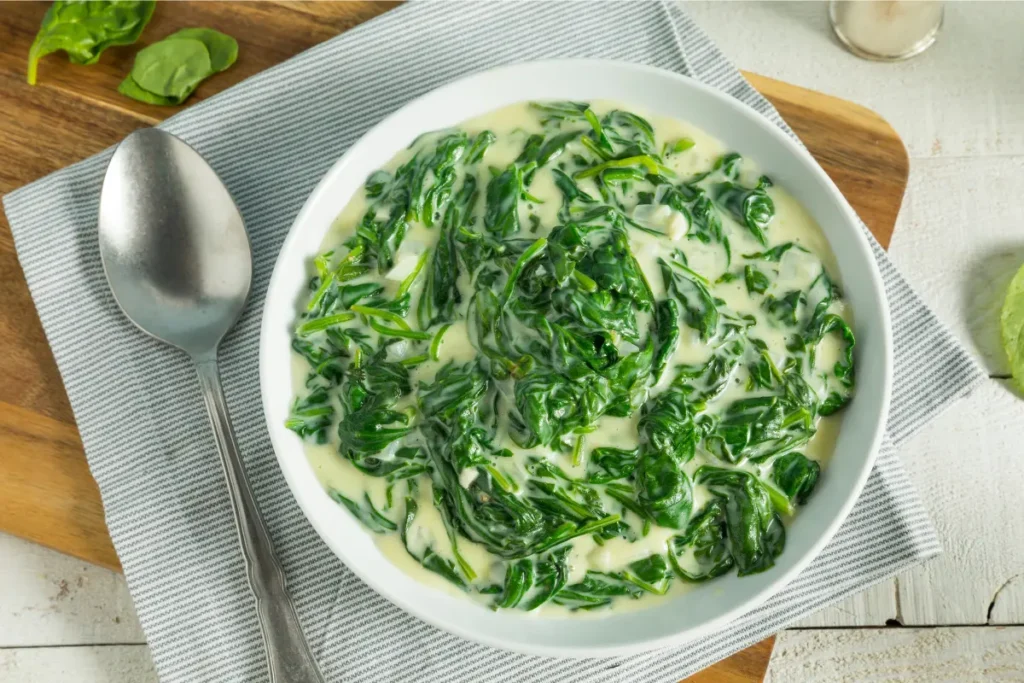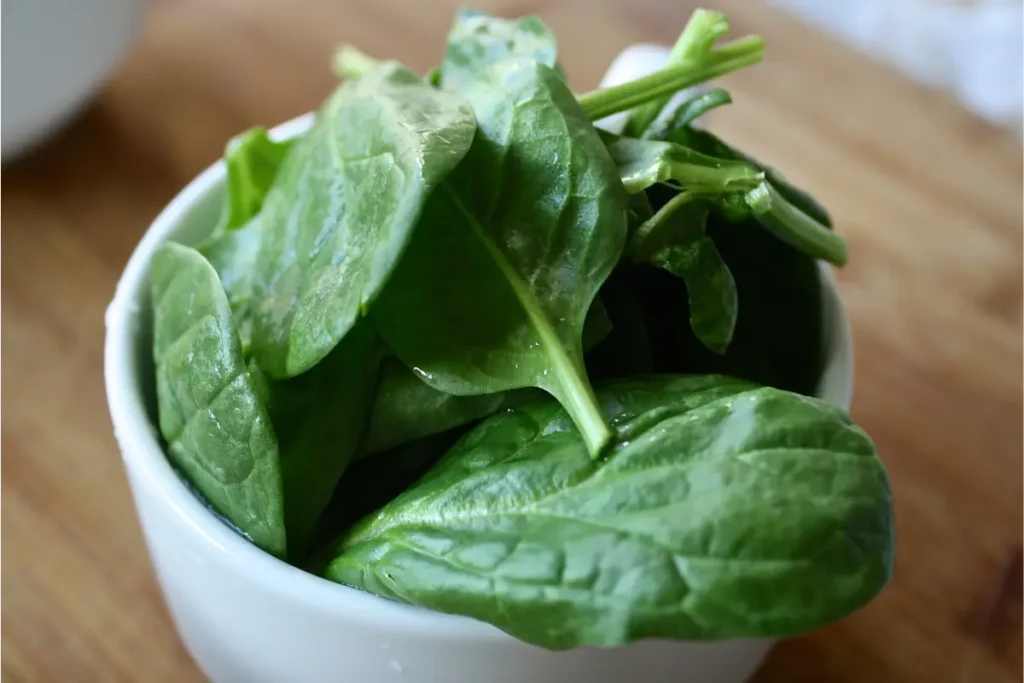In today’s health-conscious world, the question on everyone’s lips seems to be, “Is spinach dip healthy to eat?” It’s a dish we’ve all encountered – at parties, family gatherings, or as a comfort food fix. But, amidst the creamy texture and the lush green specks of spinach, one can’t help but wonder about its nutritional profile. This article dives deep into the heart of spinach dip, dissecting its ingredients, health implications, and how it fits into a balanced diet. So, let’s embark on this flavorful journey, shall we?

Part 1: Introduction to Spinach Dip
Ah, spinach dip – a concoction that has found its way into our hearts and, of course, our stomachs. But what’s the real scoop behind this beloved appetizer? Is it a friend or a foe to our health? Below, we’ll peel back the layers of this popular dish, exploring its versatility and why it’s become a staple at many a dining table.
Popularity and Versatility of Spinach Dip
Spinach dip, oh how we adore thee! It’s creamy, it’s dreamy, and boy, does it pack a flavor punch. Whether it’s nestled in a bread bowl at a party or served alongside crispy veggies, its popularity is undeniable. But, here’s the kicker – not all spinach dips are created equal. From the traditional mayonnaise and sour cream base to the more modern, health-conscious alternatives, there’s a world of variety out there. And it’s this versatility that makes spinach dip such a fascinating subject. With the right tweaks, it can either be a decadent treat or a nourishing snack. So, the next time you’re dipping into that bowl, remember, the choice of ingredients can turn it from a guilty pleasure into a healthy delight.
Part 2: Nutritional Overview of Spinach Dip
What Goes into Spinach Dip?
When you think of spinach dip, you might imagine a green, creamy spread that’s just begging to be scooped up with a crunchy chip. But, what’s really in it? Typically, spinach dip involves a mix of chopped spinach, mayonnaise, sour cream, and often, a packet of seasoning or soup mix. Some recipes throw in artichokes, garlic, and various cheeses for extra flavor and richness. It sounds heavenly, right? But here’s the catch: while spinach itself is a nutritional powerhouse, its benefits can be overshadowed by the high-calorie, high-fat company it keeps in this dish. Now, don’t get me wrong, fats aren’t inherently evil. In fact, our bodies need healthy fats to function. However, the key lies in balance and choosing ingredients that contribute to our health rather than take away from it.
Nutritional Benefits of Spinach
Let’s shine a spotlight on the star of the show: spinach. This leafy green is not just for Popeye! It’s loaded with vitamins A, C, and K, minerals like magnesium and iron, and is a great source of dietary fiber. Spinach is a real superfood, offering antioxidants that combat oxidative stress and reduce the risk of chronic diseases. Including spinach in your diet can boost eye health, promote heart health, and even improve muscle strength. So, the next time you whip up a batch of spinach dip, remember, the spinach isn’t just there for color – it’s a nutritional powerhouse eager to flex its muscles in your diet.
In this section, we’ve peeled back the layers of spinach dip to reveal what’s inside and highlighted the nutritional superstar that is spinach. However, as we move forward, we’ll uncover how the traditional components of spinach dip might need a little tweaking to truly make it a healthy choice. Stay tuned as we explore the potential health concerns and how to adjust your dip for the better.

Part 3: Health Considerations
Potential Health Concerns with Spinach Dip
Now, don’t let this put a damper on your dip enthusiasm, but it’s crucial to acknowledge the potential health concerns associated with traditional spinach dip recipes. The usual suspects – mayonnaise and sour cream – are often high in saturated fats and calories. And while a little bit of what you fancy does you good, too much can contribute to unwanted weight gain and increase the risk of heart disease. Moreover, those delightful seasoning packets that effortlessly imbue our dip with flavor can be laden with sodium, posing a risk to blood pressure levels.
But fear not! Recognizing these potential pitfalls is the first step towards creating a healthier version that doesn’t skimp on taste. So, before you swear off spinach dip forever, let’s explore how adjustments and substitutions can transform this appetizer into a guilt-free pleasure.
Dietary Restrictions and Spinach Dip
Tailoring spinach dip to cater to various dietary restrictions not only makes it more inclusive but can also enhance its nutritional profile. For those watching their calorie intake or managing heart health, swapping out high-fat mayonnaise and sour cream for Greek yogurt or a plant-based alternative can make all the difference. This simple switch adds protein while reducing the fat content, without compromising the creamy texture we all love.
For the lactose intolerant or dairy-free folks, fear not! The versatility of spinach dip means you can still indulge. Many dairy-free yogurts and cheeses offer a similar richness and tang, ensuring no one misses out on this delicious treat. By paying attention to these substitutions, we can welcome spinach dip back into the fold, not as a guilty pleasure, but as a dish that everyone can enjoy, regardless of their dietary needs.
Achieving the perfect texture while keeping the dip healthy is crucial. For tips on thickening without adding excessive calories, see How Do You Thicken Spinach Dip
In this part, we’ve peeled back the creamy top layer of spinach dip to examine the potential health concerns lurking beneath. But, as we’ve seen, with a few smart swaps, we can mitigate these issues and welcome spinach dip back into our lives, this time as a healthier version. Stay tuned as we delve into specific tips for making your spinach dip a beacon of health in the next part of our series.
Part 4: Making Spinach Dip Healthy
Embarking on a Healthier Journey
The path to a healthier version of spinach dip begins with careful selection of ingredients. Our aim is to boost the nutritional profile without losing the beloved creamy and indulgent texture of the dip.
Opt for Greek Yogurt
Creamy Yet Healthy:** Substituting mayonnaise and sour cream with Greek yogurt is a simple yet effective way to reduce calories and fat while enhancing the protein content. This adjustment maintains the dip’s creaminess and adds a tangy flavor that perfectly complements the spinach.
Vegetable Variety
- Enhancing Flavor and Nutrition: Broadening the dip’s vegetable base beyond spinach by including artichokes, red peppers, or carrots not only diversifies its flavor but also increases its fiber and overall nutritional value.
Cheese Selection
- Balancing Flavor with Health: Choosing lower-fat cheese options or using smaller quantities of flavorful cheeses like sharp cheddar or Parmesan allows you to enjoy the richness of cheese in a way that’s better for your heart.
DIY Spice Mix
- Custom Flavor Without the Salt: Creating your own spice blend with ingredients like garlic powder, onion powder, dried herbs, and a hint of salt offers full control over the dip’s flavor profile while avoiding the excess sodium found in pre-packaged seasoning mixes.
Thoughtful Serving Suggestions
- A Rainbow of Nutrients: Opting for a colorful assortment of fresh vegetables for dipping instead of traditional chips or bread not only makes the appetizer healthier but also adds a variety of textures and nutrients.
For those intrigued by a specific recipe that exemplifies these healthier ingredient swaps, the Knorr Spinach Dip Recipe serves as an excellent reference. This recipe showcases how simple adjustments can result in a deliciously healthy version of the classic spinach dip
By embracing these tips, you’re not just making a dip; you’re crafting an experience that delights the taste buds while nourishing the body. It’s all about finding the perfect balance between health and flavor, proving that indulgence and well-being can indeed go hand in hand.
Part 5: Spinach Dip in a Balanced Diet
Incorporating Spinach Dip into a Healthy Diet
In the vast landscape of a balanced diet, the placement of spinach dip is a matter of context and moderation. Here’s a closer look at how this favorite can fit into a healthy eating plan without feeling like a compromise.
Mindful Portion Sizes
- The Art of Moderation: Serving size is key. A small portion of spinach dip can enrich your meal with flavor without leading to overindulgence. It’s about enjoying the dip mindfully, allowing you to appreciate its taste fully.
Strategic Timing
- Pre-Meal Strategy: Using spinach dip as a pre-meal appetizer can be an excellent way to introduce vegetables early on. The timing of your indulgence can enhance your dining experience, setting a healthy tone for the rest of the meal.
Balanced Pairings
- Complementary Combinations: The company spinach dip keeps on your plate matters. Aim to pair it with lighter, nutrient-rich dishes. This balance ensures that the dip’s richness enhances rather than overshadows your meal.
Diverse Dipping Delights
- Choosing Healthier Dippers: The selection of dipping companions significantly impacts the nutritional value of your snack. Opting for vegetables over chips or bread not only lowers calorie intake but also introduces a variety of nutrients and textures.
Spinach Dip as a Meal Component
- Innovative Meal Ideas: Spinach dip doesn’t have to be just a side or an appetizer—it can be a star ingredient in a meal. Incorporating it into a salad bowl adds flavor and nutrition, creating a dish that’s satisfying in every aspect.
By weaving spinach dip into your diet with these mindful strategies, you’re not merely indulging in a delicious treat; you’re adopting an approach that harmonizes the joy of eating with the principles of healthful living. This philosophy affirms that creativity and moderation can expand the role of even the most indulgent foods within a balanced diet.
For those eager to delve deeper into making informed dietary choices that beautifully balance indulgence and nutrition, professional dietary advice from the Academy of Nutrition and Dietetics is an invaluable resource. This link offers access to expert guidance on crafting a diet that supports health without compromising taste, including how to enjoy versatile dishes like spinach dip within a nutritious eating plan

Part 6: FAQs
Frequently Asked Questions
Is spinach dip high in calories?
Well, it can be, depending on what goes into it. Traditional recipes that lean heavily on mayonnaise and sour cream tend to be higher in calories. However, by swapping in Greek yogurt or low-fat alternatives, you can enjoy a lighter version without compromising on taste.
Can spinach dip be part of a weight loss diet?
Absolutely! The key is moderation and mindful ingredient selection. Opt for a recipe that uses healthier alternatives and serve it with a rainbow of vegetables for dipping. This way, you can savor the flavors of spinach dip without derailing your diet goals.
Is it possible to make a dairy-free spinach dip?
You bet! There are plenty of plant-based yogurts and cream cheese alternatives that can mimic the creamy texture you crave. Not to mention, these substitutions can make your dip more inclusive for those with dietary restrictions.
What are the best vegetables to serve with spinach dip for a health boost?
Think colorful and crunchy! Carrots, bell peppers, cucumber, and cherry tomatoes not only add a pop of color to your platter but also pack a nutritional punch. Plus, their crisp texture contrasts beautifully with the creamy dip.
How can I increase the protein content in my spinach dip?
Greek yogurt is your friend here. Not only does it offer a creamy base, but it also significantly ups the protein ante. For an extra boost, consider adding a scoop of unflavored protein powder or blending in some white beans for a smooth, protein-rich addition.
By addressing these FAQs, we hope to have illuminated the path to enjoying spinach dip in a way that aligns with health-conscious eating. Remember, it’s all about the choices you make, both in the kitchen and at the dining table. As we wrap up this section, we’ve seen how spinach dip can be tailored to fit various dietary needs and preferences, proving that this beloved appetizer can indeed have a place in a balanced, nutritious diet. Stay tuned for our concluding thoughts on this flavorful journey.
Part 7: Conclusion
Final Thoughts on Spinach Dip’s Healthiness
Spinach dip has stood the test of time as a favorite go-to appetizer for its irresistible taste and social snack appeal. What we’ve discovered on this journey is that its healthiness largely depends on the choices we make—both in preparation and consumption. By embracing ingredient swaps and mindful eating practices, we can transform spinach dip from a calorie-dense indulgence to a nutritious, enjoyable part of a balanced diet.
The versatility of spinach dip allows it to be customized to fit dietary needs and preferences, proving that with a bit of creativity, we can enjoy the foods we love in a way that also loves us back. Whether it’s opting for Greek yogurt to cut down on fat, incorporating a rainbow of veggies for dipping, or making the dip a centerpiece of a balanced meal, there are countless ways to enjoy spinach dip healthfully.
In essence, spinach dip can be much more than just a party appetizer; it can be a gateway to exploring healthier eating habits without sacrificing flavor. As we continue to navigate the vast culinary landscape, let’s remember that balance, moderation, and mindful ingredient selection are key to enjoying our favorite foods in a way that nourishes our bodies and satisfies our taste buds.
As we bid adieu to our deep dive into spinach dip, may this exploration inspire you to experiment with your recipes, making healthier choices that don’t skimp on flavor. Here’s to delicious, nutritious snacking—may your spinach dip be a testament to the fact that health and indulgence can indeed go hand in hand.

